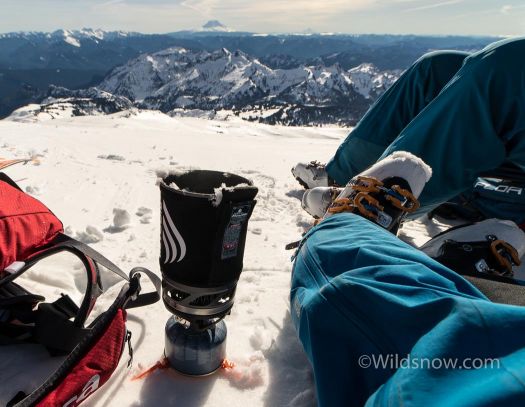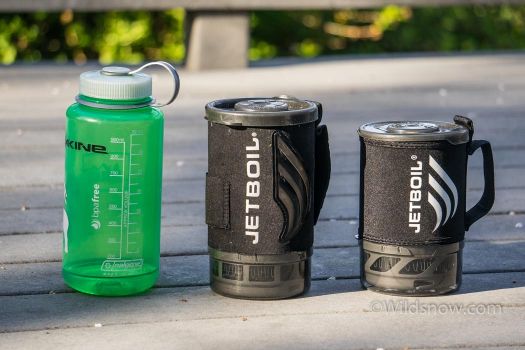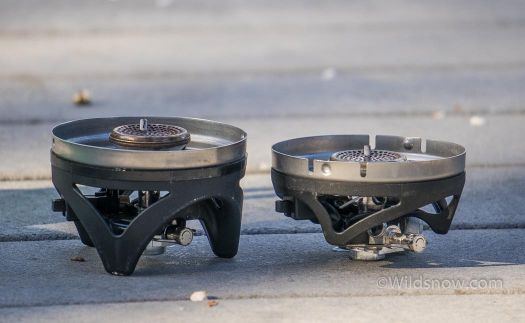Jetboil changed the game a few years ago when they burst onto the scene with their revolutionary, fast cooking system. It provided exceptional efficiency and a easy, tightly integrated setup. Since then, a variety of manufacturers have come up with similar products. Imitation is the purest form of flattery, or so they say.
Canister cooking systems all had similar disadvantages. Namely price, canister availability, cold weather performance, and an inability to simmer. I hesitated to get one for years for all these reasons, however the major deterent was their simmering handicap. Boiling water is good, but being able to make pasta or couscous is necessary for delicious meals while camping. Also, if you’re purifying water, you need to be able to simmer it for a few minutes to fully kill everything nasty.
The Jetboil MicroMo caught my interest when I learned about its improved ability to simmer.

Melting snow in the sun up on Mt. Rainier.
Many outdoor companies obsess with change and new products, rather than simply enhancing what works. As a designer, this attitude is a major pet peeve of mine, as it often results in incompatible products and discontinuations of excellent items, often in favor of something inferior. Jetboil has been a shining antithesis of this. They started out with a product that worked quite well. Over the years, they’ve kept the same basic formula. However, instead of sitting on their hands, they’ve consistently and carefully made incremental improvements. Jetboil’s different sizes and types of pots are integrated, but still compatible across their product line, even with older models. Their products have evolved with noteworthy enhancements. Kudos.
Jetboil’s new MicroMo is an excellent example of this. The system is similar to their other stoves, with upgraded features. For one, it’s smaller and lighter. The burner assembly is shorter, as well as the pot that comes with the stove. The smaller burner is actually more powerful than the older larger ones. It spits out 6,000 BTU compared to the 4,500 BTU of the Jetboil Flash. In addition, it dials down to simmer quite nicely, a win-win. The internal components are tweaked so it takes multiple turns of the knob to get to full power. This means that the burner can be easily adjusted to a tiny flame with minimal heat output.
In the past my Jetboil (and other integrated cannister stove) cooking experience usually went something like this: boil water, add pasta, almost immediately it boils over, frantically attempt to turn the stove off (without finger burns), let it sit for a bit, turn it on again, it boils over again…you get the picture. At the end, burned food is inevitably stuck to the bottom of the pot. Making tea or freeze-dried meals was easy, and that’s about it. I’m sure better cooking can be done, but it’s undeniably difficult. In contrast, the MicroMo simmers wonderfully. After dialing the flame down I can calmly stir my macaroni to al-dente perfection. I’ve got to remember the chef hat on my next trip.

The MicroMo compared to a “standard” original Jetboil size. (Nalgene for scale). The MicroMo has a smaller burner, so the fuel, burner, and fuel stand still fits inside the .8L pot.

Burner size comparison. Original Jetboil burner on the left, MicroMo on the right. The size variation mostly comes from the different plastic parts. The burner parts look quite similar, although the MiniMo delivers both higher heat output, and better simmering.
I’ve been using the stove throughout the winter on a short overnight trips as well as day trips. The smaller burner and pot make the stove setup quite compact. It efficiently melts snow on day trips. The pot is small, and isn’t quite big enough for two people on an overnight (although it does work). With the standard flame-thrower Jetboil, it’s necessary to leave a large space when filling the pot with water, because the stove boils so aggressively. However, since the MicroMo burner simmers so well, it’s possible to fill the pot almost completely full. There is still a warning on the pot to only fill it ¾ full, but I’ve successfully ignored that several times. With a bit of care and attention, it’s possible to boil almost the same amount of water in the MicroMo’s small pot as in the larger standard pot. The stove is still compatible with larger Jetboil pots, which I’ve used on several trips.
I’ve always had issues with the piezo lighters on both Jetboil and other brands of self-lighting canister stoves. Sometimes they work, but mostly they don’t. They’re fragile, and susceptible to the tiniest amount of moisture. Mine stopped working almost immediately. Perhaps I wasn’t careful enough and bumped the tiny wire that creates the spark. Whatever the case, the little button is entirely ineffective (even though it often still makes a tiny spark). I’m sure Jetboil would warranty the issue, but I’ve seen the same issue in many other cases, so I’m not sure it wouldn’t stop working again soon after being fixed. Either way, the fact that it’s unreliable means that you need a lighter on hand anyways, obviating the usefulness of the mechanism. It’s a relatively minor issue, but there’s room for improvement. Perhaps a purely mechanical sparker, like the type used on a lighter, would be more robust.
As an integrated canister stove, Jetboil has some known disadvantages: canisters struggle to maintain pressure in very cold weather, plus the cost and the weight of several canisters is not ideal on longer trips. However, the MiniMo’s compact, light-weight size and excellent simmering function, tips the scales solidly in it’s favor. After years of holding out, I’m convinced that it’s the way to go for the majority of my backcountry trips. On those few longer, colder trips where white gas is still ideal, I’m sure I’ll be wishing for the cute little MicroMo as I torch my eyebrows.
Specs of the system, all verified by myself except the BTU:
6,000 BTU
Weight of burner and pot: 11.6 oz (328 gr).
Weight with full 100 g fuel and fuel stabilizer: 19.1 oz (541 gr)
Dimensions: 15.5 x 10 x 10 cm
Pot capacity: 26 oz (.77 liter)
Louie Dawson earned his Bachelor Degree in Industrial Design from Western Washington University in 2014. When he’s not skiing Mount Baker or somewhere equally as snowy, he’s thinking about new products to make ski mountaineering more fun and safe.
